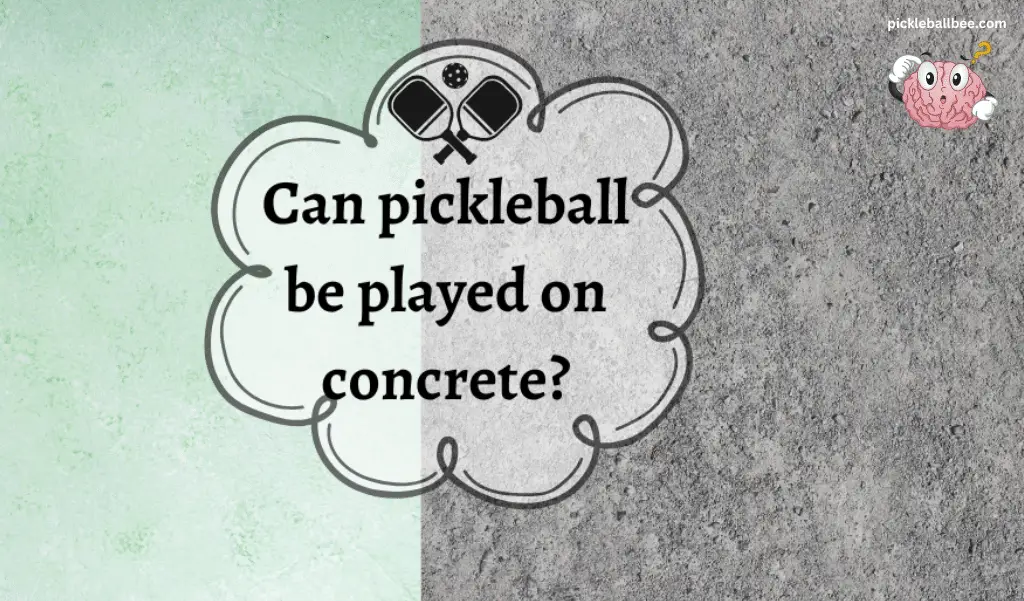Pickleball! The name itself is enough to spark intrigue. This fun, fast-paced game has exploded in popularity over the last decade. But have you ever wondered, “What is a pickleball made of?” It’s a simple question with a fascinating answer, which we will unpack in this article.
What is a Pickleball Made of? Materials Used in a Pickleball

Pickleballs are primarily made using specific materials to ensure optimal performance and durability. The main materials used in pickleball are:
High-Quality Plastic:
The outer shell of a pickleball is typically constructed using high-quality plastic materials. This plastic is chosen for its durability, resistance to impact, and ability to withstand the rigors of gameplay.
Polymer Composite:
Many pickleballs use a polymer composite, a mixture of different plastic materials. This composite helps to create a balance between the ball’s weight, bounce, and flight characteristics, enhancing the overall playability.
Additives:
Some manufacturers incorporate additives, such as stabilizers or UV inhibitors, into the plastic mix. These additives can improve the ball’s resistance to sunlight and environmental factors, ensuring the pickleball maintains its performance over time.
Cork Core (Optional):
In some specialty pickleball, a cork core may be used instead of the traditional plastic core. This cork core provides a unique feel and sound upon impact, catering to players who prefer a more traditional touch.
Seam Tape:
The two halves of the pickleball are often combined with seam tape. This tape helps to hold the ball together securely, preventing any separation during play.
These materials are carefully selected and combined to meet the specific standards set by regulatory bodies, ensuring that pickleball is consistent in performance and can withstand the demands of the game.
Manufacturing Process of Pickleball
Oh boy, the manufacturing process of a pickleball, now that’s an interesting journey! Are you ready to uncover the secrets? Let’s get started!
1. Material Selection:
The first step is to pick the right material. The most common plastic used to make pickleballs is Acrylonitrile Butadiene Styrene (ABS). Why, you ask? ABS has an impressive knack for withstanding harsh weather conditions and high-impact hits. It’s like the Superman of plastics!
2. Heating it:
Once the ABS is chosen, it’s heated to a high temperature, turning it into liquid. This is like prepping the dough before you can make your favorite cookies.
3. The Mighty Mold:
Now comes the exciting bit! The liquid ABS is injected into a specialized mold shaped like a hollow pickleball. Please think of this as the cookie cutter for our ABS dough.
4. Cooling Down:
Once the ABS fills the mold, it can cool and solidify. This process transforms it from a blob of plastic into a hard, sturdy ball.
Popping it Out When the ball has cooled down, it’s then removed from the mold. At this point, it’s starting to look a lot like a pickleball.
5. Hole Drilling:
But wait, we’re missing something. The holes! A machine is used to drill evenly spaced-holes around the ball. It’s these holes that give the pickleball its unique flight characteristics.
6. Finishing Touches:
The last step is to clean and polish the ball. This process ensures that any leftover material from the drilling process is removed and the ball is smooth to touch.
And there you have it! Your very own pickleball, ready to whizz through the air in a heart-pounding game. Who would have thought a simple little ball could have such an intricate journey?
Different Types of Pickleballs

There are mainly two types of pickleball:
Indoor Pickleballs: These have larger holes and are typically lighter. They are designed for indoor courts where the wind is not a factor.
Outdoor Pickleballs: These have smaller, more numerous holes and are slightly heavier. They are designed to withstand windier conditions and rougher outdoor surfaces.
For pickleball newbies, distinguishing between the two types of balls is no small feat—it’s vital!
What’s The Difference Between Indoor And Outdoor Pickleball?
Materials of Indoor and Outdoor Pickleballs
Pickleballs, whether designed for indoor or outdoor use, are primarily made from durable, lightweight plastic known as high-density polyethylene (HDPE). However, the construction and design details vary based on their intended environment.
Indoor Pickleballs:
Indoor pickleballs are typically smoother and have larger holes than their outdoor counterparts. The larger holes are designed to help the ball travel more straight and true in an environment where wind isn’t a factor. They often feature 26 to 40 holes in their design. These balls are typically softer and lighter, which makes them slightly slower and less likely to bounce. This design caters to indoor play where the environment is controlled, and the play is often faster and requires quicker responses.
Outdoor Pickleballs:
Outdoor pickleballs are built to withstand the elements. They are generally made of a harder version of the same plastic (HDPE) and are heavier, which helps them resist the wind better. The structure of an outdoor pickleball also includes more holes—usually around 40. These holes are smaller to help the ball navigate windy conditions more effectively. In addition, outdoor balls are designed to be more durable to withstand the rougher surfaces on outdoor courts. They are typically harder and more rigid, which leads to a higher bounce than indoor balls.
Foam Pickleballs: The Ultimate Choice for Beginners

Foam pickleballs are the perfect introduction to pickleball for beginners. Their lightweight and soft construction offer a slower pace, making it easier for newcomers to control their shots. The reduced impact on the paddle and body minimizes the risk of injuries, ensuring a safer and more enjoyable experience. These balls are also ideal for indoor play, as they create less noise and are less likely to leave marks on gym floors. Whether you’re just starting or looking for a casual game, foam pickleballs are the way to go.
Foam Pickleballs for Recreational Play and Training
For recreational players and training purposes, foam pickleballs are a top choice. The softer material provides a gentler bounce, allowing players to practice various shots without excessive power. These balls are excellent for honing skills, improving hand-eye coordination, and refining techniques. Additionally, they work well for seniors and those with mobility issues, as they require less force to play with. Embrace the advantages of foam pickleball and elevate your pickleball journey with a ball that suits your needs.
Foam Pickleballs vs. Indoor Balls: A Comparison

Foam pickleball and indoor balls cater to different playing environments. Foam balls excel indoors due to their quieter nature and reduced floor marking potential. They offer a controlled pace that suits recreational and beginner’s games. Conversely, indoor balls, usually made of plastic, are designed for competitive play on indoor courts. They deliver a higher bounce and increased speed, challenging players to react quickly and strategically. Both options have their merits, but for a more relaxed and friendly game, foam pickleballs are the preferred choice.
Specifications of a Pickleball
- Material: Durable plastic, typically a combination of high-quality polymers.
- Size: Diameter of 2.874 inches (7.3 cm), slightly smaller than a tennis ball.
- Weight: Approximately 0.8 to 1.02 ounces (22.68 to 28.9 grams).
- Hole Count: Precisely 26 to 40 evenly spaced holes.
- Bounce Height: Regulation height of 30 to 34 inches (76 to 86 cm) when dropped from 78 inches (198 cm).
- Color: Commonly available in yellow and green for enhanced visibility.
- Durability: Designed to withstand rigorous gameplay for extended periods.
- Compression: Offers optimal bounce and feel upon impact.
- Surface Texture: Slightly textured for better grip and control.
These specifications ensure a consistent and enjoyable playing experience for pickleball enthusiasts across various brands and models.
Regulation and Standards for Pickleballs
Pickleball regulations and standards set by the International Federation of Pickleball (IFP) and USA Pickleball ensure fair and consistent gameplay. These rules cover various aspects of the pickleball, including its material, size, weight, and the number and shape of its holes. Let’s take a closer look at the specifics based on the 2023 Rulebook:
Ball Specifications:
The pickleball must have a design with a minimum of 26 and a maximum of 40 circular holes. These holes are spaced in a way that ensures the ball’s flight characteristics are in line with the game’s requirements. A manufacturer’s or supplier’s name or logo should be printed or embossed on the ball’s surface.
Approval Process:
The Tournament Director is responsible for selecting the official ball for tournaments. The chosen ball must be listed on the official list of approved balls on the USA Pickleball and IFP websites. This helps maintain consistency and quality across various tournaments.
Construction and Material:
The pickleball must be made of durable material and molded to have a smooth surface without any texturing. The ball must be one uniform color, except for specific identification markings. Additionally, the ball may have a slight ridge at the seam if it does not significantly impact its flight characteristics.
These regulations ensure that all pickleball in official tournaments meets the required standards, promoting fair and enjoyable gameplay for all participants. Players can be confident that the balls used in these competitions are high quality and have undergone the necessary approvals.
As players, organizers, and fans of the sport, adhering to these regulations creates a level playing field and upholds the integrity and spirit of pickleball. So, next time you step onto the pickleball court, you can be assured that the equipment used meets the official standards set by the IFP and USA Pickleball for a fantastic game!
Conclusion
To sum it all up( What is a Pickleball Made Of), pickleball is an intriguing game filled with unique details, from the materials used to make the ball to how it’s put together. It doesn’t matter if you’re playing with an indoor, outdoor, or even a foam pickleball – each one’s built differently, influencing how the game’s played. These factors ensure that anyone can enjoy a good pickleball round, regardless of whether they’re a pro or a newbie. So, with all this new knowledge, you’re ready to serve up some fun in your next game of pickleball. Understanding your gear is part of enjoying this rapidly growing game. So, let’s grab our gear and hit the court!
FAQs:
-
What is pickle balls?
Pickleballs are lightweight, durable balls used in the sport of pickleball. They’re typically made from polymer and plastic, with numerous holes for airflow during play. They’re integral to the game’s unique dynamics!
-
Why do they call pickleball pickleball?
Well, you’d think pickleball might have something to do with pickles, right? Funny enough, it doesn’t! Legend has it, and the sport got its name from “Pickle”, the dog of one of its co-founders. Pickle loved chasing the stray balls. Hence, ‘pickleball’ was born!
-
What is pickleball equipment?
Pickleball equipment consists of a lightweight composite paddle, a durable polymer ball with perforations, and a specifically dimensioned court, similar to a smaller tennis court. Comfortable athletic attire is also recommended.
-
Are there different types of pickleball?
Absolutely! There are different types of pickleball, each designed for a specific playing environment or skill level. Outdoor pickleball, with their thicker and harder material, can stand up to the wind and rougher surfaces, and they typically have 40 small holes. Indoor pickleballs, conversely, are softer and lighter, with fewer (26 to be exact) larger holes. This design makes them more responsive to the smooth, wooden indoor courts. There are also different colors available to cater to various visibility needs. So, whether you’re an indoor enthusiast or an outdoor adventurer, there’s a pickleball out there just for you!
-
Is pickleball a sport?
You bet! Pickleball is not only a sport but also one of the fastest-growing sports in the U.S. and beyond. A smashing mix of tennis, badminton, and ping-pong, pickleball is played with paddles and a perforated polymer ball, on a court similar to a badminton one. With its simple rules and friendly vibe, pickleball is inviting to all ages and skill levels. So, whether you’re looking for a competitive challenge or a fun way to stay active, pickleball hits the spot!
-
Is pickleball good for the brain?
Absolutely! Pickleball enhances brain health. It bolsters coordination, spatial awareness, and quick decision-making, providing a mental workout alongside the physical. It’s more than just a game—it’s brain fuel!


